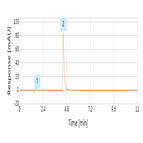Find methods for your needs
Refine by Feature
Displaying 1-3 of 3 results for Tag: NBD-amine
OSHA Method 41 for improved analysis of Diethylamine using the Thermo Scientific Acclaim Mixed-Mode HILIC-1 HPLC column
Instrument Type: HPLCAs shown here, the Thermo Scientific Acclaim Mixed-Mode HILIC-1 can analyze the diethylamine derivative under the normal-phase conditions of OSHA Method 41. In this case, 4-chloro-7-nitro-1,2,3-benzoxadiazole (NBD-chloride) reacts with amines in the trap, to produce a highly-colored, fluorescent derivative. The unreacted reagent and a trace of monoethylamine eluted at 2.3 and 4.4 minutes, respectively, and neither interferes with the analyte of interest. Compared to the existing OSHA method, the new column provides improved peak shape and faster analysis time.
Faster analyss of NBD derivatives of volatile alkylamines using a Thermo Scientific Acclaim C30 HPLC column
Instrument Type: HPLCThe Thermo Scientific Acclaim C30 resolved four common volatile amines with simple, isocratic reversed phase conditions. In this case, 4-chloro, 7-nitro, 1,2,3-benzoxadiazole (NBD-chloride) reacts with amines in the trap, to produce a highly-colored, fluorescent derivative. The unreacted reagent elutes at 5 minutes and does not interfere with the analytes of interest. This new method is compatible with four existing methods (OSHA Methods 34, 36, 40 and 41), while providing improved peak shape and faster analysis time.
OSHA Method 34 for rapid determination of dimethylamine using the Thermo Scientific Acclaim Mixed-Mode HILIC-1 HPLC column
Instrument Type: HPLCThe Thermo Scientific Acclaim Mixed-Mode HILIC-1 can analyze the dimethylamine derivative using the normal-phase conditions of OSHA Method 34. In this case, 4-chloro-7-nitro-1,2,3-benzoxadiazole (NBD-chloride) reacts with amines in the trap to produce a highly-colored, fluorescent derivative. The unreacted reagent elutes at 1.8 minutes and does not interfere with the analyte of interest. Compared to the existing OSHA method, the new column provides improved peak shape and faster analysis time.



